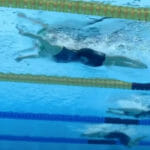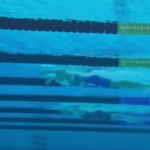Tatjana Schoenmaker vs Lydia Jacoby – Tale of two entirely different breaststroke techniques
When I witnessed American Lydia Jacoby win the Olympic gold medal in the 100 meter breaststroke, it reminded me of something all coaches need to remember about breaststroke. With whatever breaststroke technique used, it is mostly about the kick!
Based on the hundreds of Velocity Meter studies we have performed, we can conclude that with the fast women breaststrokers (who all have strong kicks), 70-80% of the average velocity is derived from the kick, not the pull. With the elite men breaststrokers, it is slightly less than that. Perhaps 60-70% of their total velocity comes from the kick.
This fact should not lead one to assume that the kick has 3 to 4 times more propulsion than the pull. It does not. It is just that shortly after the pull, the swimmer gets into a horrible drag position, with shoulders elevated out of the water and thighs drawn forward. At this moment, all breaststrokers (even elite ones) drop their speed to nearly zero. For just a brief time, they are like a buoy floating in the water. Breaststroke is truly a stop-and-go stroke. Whatever speed is derived from the pull is short lived, while the speed derived from the kick lasts longer.
The speed from the kick is much easier to sustain. After it, the swimmer gets into a relatively streamlined body position with arms hyperextended forward, legs lifted and feet pointed backward. Therefore, the speed of the elite breaststroker that occurs after the kick is not only typically greater than the speed achieved after their pull. It also sticks around much longer.
In the women’s Olympic 100 meter breaststroke final, Lydia Jacoby used almost what could be considered an old school breaststroke: Relatively slow stroke rate of 46 strokes/minute. Not much shoulder elevation. Not a whole lot of coupling going on. Barely gets her head under water. Wider kick than most elite breaststrokers. But, boy can she kick.

Low shoulder elevation of Lydia Jacoby (black cap) compared to more traditional high elevation of Sophie Hansson (Sweden – yellow cap)

Relatively wide kick of Lydia Jacoby (second swimmer from left) compared to more traditional narrower kicks
With each kick she took, Lydia surged forward with tremendous speed. Enough to win the Olympic gold medal. Here are two important rules to remember about breaststroke:
Rule #1. When coaching breaststrokers, develop the kick propulsion first. Even if it means taking the knees wider or drawing the thighs up farther than you’d like. Even if it takes years. Even if it means slowing the stroke rate. A strong kick is a must have.
Rule #2. After the kick, keep the drag low.
There are several important techniques to achieve Rule #2: Immediately get into the racing streamline position with the arms hyperextended in front and the head tucked down, chin touching the chest. Lift the legs and point the toes backward at the end of the kick. Hold a tight body line. Both Lydia and Tatjana do all of that well.
However, Tatjana taught me another new trick for Rule #2 – a trick that enabled her to set a new world record in the 200 meter breaststroke. Keep the head tucked down longer during the pulling motion.

Tatjana (top) keeps her chin down close to her chest and head underwater until her hands turn the corner for her wide pull
With her breaststroke technique, Tatjana uses the equivalent of the late breath butterfly technique. With all of the other breaststrokers in the Olympic finals, the chin begins to lift off of the chest as soon as the out-sweeping motion (lift phase) of the pull begins. Not with Tatjana.
Tatjana keeps her chin plastered to her chest, even while extending her lower back, until her hands turn the corner (using a wide pulling motion), into the propulsion phase. Finally, she lifts and throws her head and shoulders upward quickly. Then, as quickly as she gets the head up, she throws the head and shoulders immediately back downward even faster. The quick upward motion helps augment her pulling force and the quick motion downward helps augment her kicking force. She keeps the head out of the water just long enough to get the breath and take advantage of these two quick coupling motions. Then, she gets back into her racing streamline position.
Effectively, by using this late breath breaststroke technique, Tatjana keeps her head underwater for more time (where there is less drag) and she keeps herself in the bad drag position, with her head and upper body out of the water, for less time. That is smart.
I wish I had a VM study on her breaststroke to prove this, but in using this technique, she seems to hold her speed better after the kick (this is a metric we now measure routinely in all breaststrokers-the percentage loss of velocity after the kick) and she seems to accelerate more than the others after her pull. Not a bad combination.

Comparison of Tatjana (top) using wide pull and late breath vs. Lilly King (below) using narrower pull and early breath
There you have it. Two entirely different breaststroke techniques with Lydia and Tatjana, both with Olympic gold medals to show for it. The only thing the two swimmers may have in common with respect to their breaststroke technique is a strong kick.
When it comes to breaststroke technique, Rule #1 is the most important one – develop the kick. Soon, we will share with you an exciting new concept to help breaststrokers who struggle with their kicking propulsion: how to build better breaststroke kicking tools.
Stay tuned.
Yours in Swimming,
Gary Sr.

